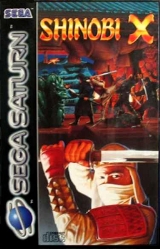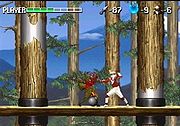
Shinobi Legions
Encyclopedia
Shinobi Legions, known as Shinobi X in Europe and Shin Shinobi Den (新・忍伝) in Japan, is a video game in the Shinobi series, developed and published by Sega
in 1995 for Sega Saturn
.
have brought the ninjitsu code and its warriors to the brink of extinction. It is time to rebuild, and find the next generation of fighters who will learn the ninja traditions. A ninjitsu master stands alone amidst the wreckage of years of warfare. In his searches, he has found three children who show promise: two brothers, Kazuma and Sho, and his own daughter Aya. He begins to train them.
Fifteen years pass. The oldest boy, Kazuma, begins to reject all the ninjitsu teachings, save one: the technique of strength. Obsessed with power, Kazuma demands that the master teach him the ultimate technique which would make his power absolute. The master refuses, and Kazuma vows to return one day and take revenge. Sho and Aya continue their studies and master the ninjitsu teachings.
Now, Kazuma has returned. He has made an army and acquired the resources to build a fortress. Although the old master has died, his pupils contain within them the secrets of the ultimate technique. Kazuma sets up a trap to lure Sho into his hideout, and kidnaps Aya to use her as a bait. The fate of the world now rests within Sho's hands.
. However this time emphasis lies on the use of Sho's katana
instead of his shuriken
, and separate buttons are now used to control them.
The four ninjitsu techniques from earlier Shinobi games have also disappeared. Instead, Sho gains his special abilities by picking up various items scattered across each level. Among them are simple power-ups (yellow and red orbs to restore his hit points) or temporary ninjitsu abilities, such as the Great Sword or the Bunshin clone shield against enemy attacks.
Also found in each level are blue orbs called life spheres. Every time the player manages to collect 10, Sho gains one continue. As usual, some item crates contain bombs that will damage Sho if he's standing too near.
 To finish the game, Sho must first go through 9 stages, each of which consists of several scenes with a boss battle at the end. Once a stage is finished, a small cinematic plays to advance the plot. The final battle is against Kazuma himself.
To finish the game, Sho must first go through 9 stages, each of which consists of several scenes with a boss battle at the end. Once a stage is finished, a small cinematic plays to advance the plot. The final battle is against Kazuma himself.
, while the cutscene music were left intact. The European soundtrack is generally considered superior to the original Japanese soundtrack and closer in style to the traditional series, as Richard had the intention of resembling the style of Yuzo Koshiro
previous compositions in the series. The North American version, published in 1995 by Vic Tokai, had retained the same music as the Japanese version.
Sega
, usually styled as SEGA, is a multinational video game software developer and an arcade software and hardware development company headquartered in Ōta, Tokyo, Japan, with various offices around the world...
in 1995 for Sega Saturn
Sega Saturn
The is a 32-bit fifth-generation video game console that was first released by Sega on November 22, 1994 in Japan, May 11, 1995 in North America, and July 8, 1995 in Europe...
.
Storyline
Years of civil warCivil war
A civil war is a war between organized groups within the same nation state or republic, or, less commonly, between two countries created from a formerly-united nation state....
have brought the ninjitsu code and its warriors to the brink of extinction. It is time to rebuild, and find the next generation of fighters who will learn the ninja traditions. A ninjitsu master stands alone amidst the wreckage of years of warfare. In his searches, he has found three children who show promise: two brothers, Kazuma and Sho, and his own daughter Aya. He begins to train them.
Fifteen years pass. The oldest boy, Kazuma, begins to reject all the ninjitsu teachings, save one: the technique of strength. Obsessed with power, Kazuma demands that the master teach him the ultimate technique which would make his power absolute. The master refuses, and Kazuma vows to return one day and take revenge. Sho and Aya continue their studies and master the ninjitsu teachings.
Now, Kazuma has returned. He has made an army and acquired the resources to build a fortress. Although the old master has died, his pupils contain within them the secrets of the ultimate technique. Kazuma sets up a trap to lure Sho into his hideout, and kidnaps Aya to use her as a bait. The fate of the world now rests within Sho's hands.
Gameplay
Shinobi Legions is a traditional side-scrolling action game, which means that each level must be finished from left to right. Along the way Sho will come across various foes and obstacles that will test the player's skill, including boss encounters. The gameplay itself is largely the same as that in Shinobi III: Return of the Ninja MasterShinobi III: Return of the Ninja Master
Shinobi III: Return of the Ninja Master, released in Japan as , is an action game developed and published by Sega for the Mega Drive/Genesis console that was released in 1993.It is the direct sequel of the 1989 game The Revenge of Shinobi...
. However this time emphasis lies on the use of Sho's katana
Katana
A Japanese sword, or , is one of the traditional bladed weapons of Japan. There are several types of Japanese swords, according to size, field of application and method of manufacture.-Description:...
instead of his shuriken
Shuriken
A shuriken is a traditional Japanese concealed weapon that was generally used for throwing, and sometimes stabbing or slashing...
, and separate buttons are now used to control them.
The four ninjitsu techniques from earlier Shinobi games have also disappeared. Instead, Sho gains his special abilities by picking up various items scattered across each level. Among them are simple power-ups (yellow and red orbs to restore his hit points) or temporary ninjitsu abilities, such as the Great Sword or the Bunshin clone shield against enemy attacks.
Also found in each level are blue orbs called life spheres. Every time the player manages to collect 10, Sho gains one continue. As usual, some item crates contain bombs that will damage Sho if he's standing too near.
Stages

- Kyoto: The battle starts at the site of this ancient ruin, in a level reminiscent of Ibaraki Province in The Revenge of ShinobiThe Revenge of ShinobiThe Revenge of Shinobi, published in Japan as is a video game developed and published by Sega in 1989. It was the first Shinobi game developed for the Sega Mega Drive, and was later released on the coin-operated version of that console, the Mega-Tech....
. The stage proceeds in a simple linear fashion as Sho makes his way across walls, bamboo forests and bridges. At the end he is confronted by a magical flying mask. - Mount Fuji: A stage designed mostly to test the player's jumping technique, Mount FujiMount Fujiis the highest mountain in Japan at . An active stratovolcano that last erupted in 1707–08, Mount Fuji lies about south-west of Tokyo, and can be seen from there on a clear day. Mount Fuji's exceptionally symmetrical cone is a well-known symbol of Japan and it is frequently depicted in art and...
has only one way to go and that's up. The player jumps from tree to tree while constantly under attack by enemy ninjas. At the top of this stage, Sho fights two boss battles. - Kazuma's Laboratory: Kazuma's Laboratory recalls the infamous Body Weapon stage of Shinobi III. In this industrial complex Kazuma performs his illegal experiments on animals, guarded by a platoon of military personnel. A genetically engineeredGenetic engineeringGenetic engineering, also called genetic modification, is the direct human manipulation of an organism's genome using modern DNA technology. It involves the introduction of foreign DNA or synthetic genes into the organism of interest...
supercreature sleeps in the central chamber of this facility. - Tunnel Trouble: Kazuma uses these tunnels to move materials from the outside world into his secret laboratory. Sho must make his way past spear and stone traps.
- Mine Ride: This stage is the heart of Kazuma's empire. Here minerals are mined and sent to fuel his army. The water below is contaminated, and the only way through is by using the mine carts. At the end of the stage is a dangerous elevator ride, but no boss guards this level.
- Jungle Heat: A level similar to Mount Fuji, Jungle Heat requires Sho to leap from vine to vine while dodging poisonous snakes and cannon fire.
- Hong Kong Harbour: This stage recalls the Breakwater scene from the New York level in The Revenge of Shinobi. In this dangerous level, Sho must leap from boat to boat while fending off Kazuma's minions. One step wrong and he winds up in the water.
- Mountain Pass: Sho is at the foot of Kazuma's fortress. Eagles circle this steep canyon, while giants keep pounding on the rocky floors to rain down showers of boulders upon Sho. The exit is closely guarded by a relentless killing machine.
- Kazuma's Fortress: Sho arrives at Kazuma's fortress just in time. His brother has extracted the ultimate technique through artificial means and his power is growing. If Sho can't stop him now no-one will.
Development
The European version of Shinobi Legions, published by Sega Europe and renamed Shinobi X, was delayed and released in 1996 due to the fact that Sega Europe's producer David Nulty disliked the original music score and wanted to change it for the European release, in a similar way that Sega of America did years before with the North American release of Sonic CD. The whole in-game tracks were replaced by noted British video game composer Richard JacquesRichard Jacques
Richard Jacques is a British music composer. He is best known for his video game music, most notably for numerous video games created by Sega.-Early life:...
, while the cutscene music were left intact. The European soundtrack is generally considered superior to the original Japanese soundtrack and closer in style to the traditional series, as Richard had the intention of resembling the style of Yuzo Koshiro
Yuzo Koshiro
is a Japanese video game music composer and audio programmer. He is regarded as one of the most influential innovators in chiptune music and video game sound design...
previous compositions in the series. The North American version, published in 1995 by Vic Tokai, had retained the same music as the Japanese version.

